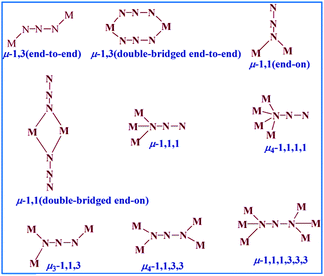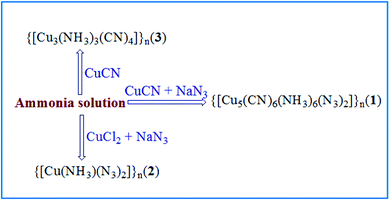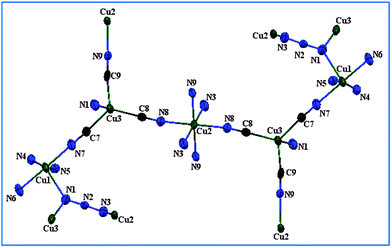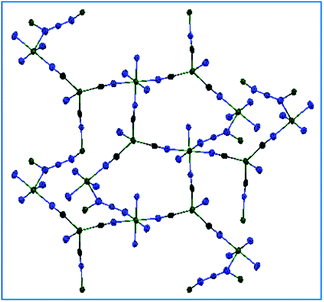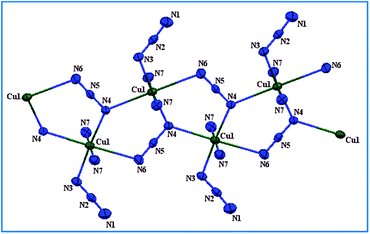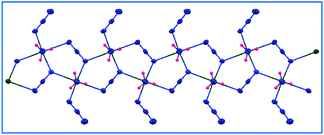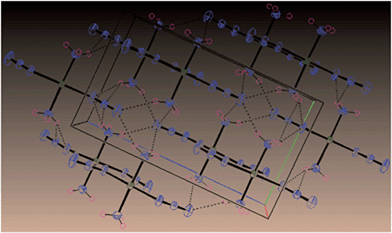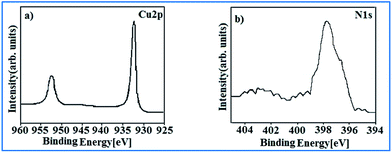A cyano and end-to-end azido bridged 3D copper(II)–copper(I) mixed-valence coordination polymer and its transformation to copper nitride nanoparticles†
Manoj Trivedi*a,
Gurmeet Singha,
Abhinav Kumarb and
Nigam P. Rath*c
aDepartment of Chemistry, University of Delhi, Delhi-110007, INDIA. E-mail: manojtri@gmail.com; gurmeet123@gmail.com
bDepartment of Chemistry, Faculty of Science, University of Lucknow, Lucknow-226 007, India
cDepartment of Chemistry & Biochemistry and Centre for Nanoscience, University of Missouri-St. Louis, One University Boulevard, St. Louis, MO 63121-4499, USA. E-mail: rathn@umsl.edu
First published on 29th July 2014
Abstract
A new cyano and end-to-end azido bridged 3D copper(II)–copper(I) mixed valence polymer, {[Cu5(CN)6(NH3)6(N3)2]}n (1), copper-azide systems without cyanide {[Cu(NH3)2(N3)2]4}n (2), and a cyano-bridged copper analogue without azide {[Cu3(NH3)3(CN)4]}n (3) have been prepared and their structures have been revealed by X-ray crystallography. The cyano groups acting as μ2,η2 and azido anions have a rare asymmetric μ-1,1,3 bridging mode connecting the copper centers in 1 to form an infinite 3-D layered motif, whereas 2 consists of one dimensional polymer chains bridged by two azide moieties in μ-1 and μ-1,1,3 modes and 3 is a two dimensional CuIICuI infinite polymeric network formed by cyanide bridges. The solid-state transformation of all the three compounds has also been investigated. The present investigation suggests application of {[Cu5(CN)6(NH3)6(N3)2]}n (1) as a precursor for copper nitride nanoparticles.
Introduction
Metal–azido complexes have attracted considerable research interest for many years due to their fascinating structural diversities, their importance in understanding magneto-structural correlations, and their promising potential applications in functional materials.1 The azido ligand is well-known for its versatile bridging modes (Scheme 1) besides its monodentate terminal coordination.2 Commonly, it binds the metal ions either through μ-1,1-N3 (end-on, EO) or μ-1,3-N3 (end-to-end, EE) bridging modes.3 Other possible bridging modes of azido ligand are μ-1,1,1-N3 and μ-1,1,3-N3.4 The rare variety of coordination modes, e.g., μ-1,1,1,1-N3, μ-1,1,3,3-N3 and μ-1,1,1,3,3,3-N3 have also been reported in some compounds.5 It is to be noted that in all these cases, only the two terminal nitrogen atoms of the azido ligand are involved in bonding. More significantly, azides are able to predictably transmit certain types of magnetic exchange, depending on their bridging modes. The general rule is that end-on azides transmit ferromagnetic interactions and end-to-end azides transmit antiferromagnetic interactions.6 Other interesting magnetic phenomena have also been observed in systems with mixed azide bridging modes.7 In the past two decades, several mono- or multi-dimensional metal–azido derivatives have been reported,8 and high dimensional metal–azido complexes are still the focus for researchers for their interesting topology and magnetic properties.9 The common strategies for this purpose reported in the literature include the further extension of metal–azido assemblies by introducing a second bridging ligand10 or the use of more azido ligands by adding a counter-cation, such as Cs+ or N(CH3)4+,11 or by employing chelating diamine ligands, such as ethylenediamine and its derivatives,12 to alter the network topology. When secondary bridging ligands are used for constructing high-dimensional metal–azido systems, neutral organic ligands have been most popular, while the use of bridging anionic ligands is relatively rare. Incorporation of bridging anionic ligands into metal–azido systems is still a challenge due to the competition of the negatively charged ligand with azide in the self-assembly process.13,14 Metal nitrides have attracted considerable attention because of unique catalytic, optic, and magnetic properties. Recently, Copper nitride (Cu3N), which has a cubic anti-ReO3 crystal structure, has engendered wide attention because of their versatile properties and potential applications in electronic devices.15 Various investigators have reported the preparation of Cu3N nanoparticles at high pressure or high temperature.15,16 If Cu3N could be prepared without the need for high pressure or temperature, Cu3N nanoparticles could be easily mass produced. Keeping these aspects in mind, herein, we report the synthesis, spectroscopic characterization of a new cyano and end-to-end azido bridged copper(II)–copper(I) mixed valence polymer, {[Cu5(CN)6(NH3)6(N3)2]}n (1), and its solid-state transformation to pure copper nitride nanoparticles. In addition, we also describe the synthesis, and spectroscopic characterization of cyano-bridged Cu(II) analogue (without azide) and Cu-azide systems (without cyanide) and their decomposition studies.Experimental
Materials and physical measurements
All the synthetic manipulations were performed under oxygen atmosphere. The solvents were dried and distilled before use following the standard procedures.17 Copper cyanide, ammonia solution, sodium azide, and copper(II) chloride anhydrous (all Aldrich) were used as received. Elemental analyses were performed on a Carlo Erba Model EA-1108 elemental analyzer and data of C, H and N is within ±0.4% of calculated values. IR (KBr) was recorded using Perkin-Elmer FT-IR spectrophotometer. The structural characterization of the fired products at 250 °C and 450 °C were done using X-ray diffraction (XRD) measurements using a Bruker D8 Discover X-ray diffractometer, with Cu Kα1 radiation (λ = 1.5405 Å). Small quantities of the pyrolyzed products were dispersed in isopropyl alcohol by sonicating for about 30 min. 5 μL of the suspension was put on copper grids using a microliter pipette for TEM measurements that was carried out using a FEI TECNAI G2 200 kV transmission electron microscope. X-ray photoelectron spectrometer (XPS), Perkin-Elmer model 1257, was employed to study the chemical states, structure and composition of different elements present in the specimen. Crystals suitable for single crystal X-ray analyses for {[Cu5(CN)6(NH3)6(N3)2]}n (1), {[Cu(NH3)2(N3)2]}n (2), and {[Cu3(NH3)3(CN)4]}n (3) were grown from slow evaporation at room temperature. Preliminary data on the space group and unit cell dimensions as well as intensity data were collected on X-calibur S oxford diffractometer using graphite monochromated Mo-Kα radiation. CrysAlisPro, Agilent Technologies software packages18 were used for data collection and data integration for 1 to 3. Structure solution and refinement were carried out using the SHELXTL-PLUS software package.19 The non-hydrogen atoms were refined with anisotropic thermal parameters. All the hydrogen atoms were treated using appropriate riding models. The computer programme PLATON was used for analyzing the interaction and stacking distances.19Syntheses and characterization
Results and discussions
Syntheses
1 and 2 were prepared as dark blue and green colored crystals by the reaction of CuCN/anhydrous CuCl2 with a concentrated solution of NH3 (25%) containing four equivalent of NaN3 under stirring at room temperature, while 3 (without azide) was synthesized by the reaction of CuCN with a concentrated solution of NH3 (25%) at room temperature. These coordination polymers {[Cu5(CN)6(NH3)6(N3)2]}n (1), {[Cu(NH3)2(N3)2]4}n (2), and {[Cu3(NH3)3(CN)4]}n (3) were obtained in good yield by slow evaporation (Scheme 2). Complex 1–3 are air stable solids, insoluble in water and other common organic solvents but soluble in dimethyl sulfoxide and do not show any signs of decomposition in solution upon exposure to air for days.Spectroscopy
The elemental analyses for 1 and 3 were consistent with their chemical formula, while we drop to record the elemental analysis of 2 because of explosive nature. IR spectrum of complex 1 shows the characteristic band at 2036 cm−1, 2068 cm−1, and 2092 cm−1 corresponding to bridging azide group in asymmetric μ-1,1,3 manner which are in good agreement with the literature values for bridging azido group.20 The cyano stretching band observed in 1 at 2137 cm−1 indicate the existence of cyanide group in μ2-bridging modes, while in 3, cyano stretching band appeared at 2143 cm−1, and 2104 cm−1 indicate the existence of two types of cyanide groups with μ2 and μ3-bridging modes.Description of crystal structures
The single crystal X-ray structural analysis of {[Cu5(CN)6(NH3)6(N3)2]}n (1) reveals an infinite three-dimensional architecture with three crystallographically independent Cu atoms bridged by μ2,η2 cyanide an asymmetric μ-1,1,3 azido groups (Fig. 1). There are three kinds of coordination modes for the Cu atoms. The first divalent Cu atom (Cu1) is coordinated by nitrogen atom of three ammonia molecules (N4, N5 and N6) [Cu(1)–N(4) 2.018(7) Å; Cu(1)–N(5) 2.016(8) Å; Cu(1)–N(6) 2.029(7) Å], one (μ2,η2)-cyanide [C(7)–N(7) = 1.152(12) Å], and one μ-1,1,3 azido group [Cu(1)–N(1) = 2.398(8) Å] and exhibits a distorted square pyramidal coordination environment. The second divalent Cu atom (Cu2) is coordinated by four (μ2,η2)-cyanide [N(8)–C(8) = 1.143(12) Å; N(9)–C(9) = 1.155(12) Å] groups, and two μ-1,1,3 azido groups [Cu(2)–N(3) = 2.547 Å] and exhibits distorted octahedral coordination environment. The third monovalent Cu atom (Cu3) displays primary CuC3 trigonal geometry consisting of three cyanides in (μ2,η2)-manner [N(8)–C(8) = 1.143(12) Å; N(9)–C(9) = 1.155(12) Å; C(7)–N(7) = 1.152(12) Å], which is very common for Cu(I) and one μ-1,1,3 azido group is very weakly bonded to Cu3. All Cu–N and Cu–C bond distances are in the range of 1.980(8) to 2.398(8) Å and 1.926(9) to 1.966(10) Å, respectively and comparable to the values reported in the literature.20–22 The alternating linkages of the five Cu atoms and four cyanide and one azido groups form an 16-membered pentagonal repeating unit [Cu5(CN)4(N3)] in the lattice (Fig. 2). The approximate size of 16-membered pentagonal rings is 8.960 × 6.759 Å2 based on the metal–metal distances.The copper atoms are bridged by the μ2,η2-cyanide and μ-1,1,3 azido ligands to afford a three dimensional (3-D) layered motif (Fig. 3a). Pentagonal channels are present within the framework of 1(Fig. 3b). Crystal packing in complex 1 is stabilised by N–H⋯N hydrogen bond interactions (see Fig. S1, ESI†). The N–H⋯N interactions are in the range of 2.27–2.61 Å.
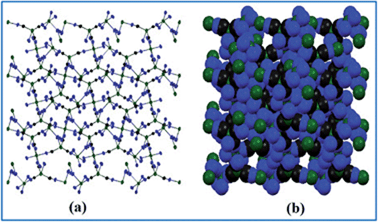 | ||
| Fig. 3 (a) 3-D layered network of 1, and (b) spacefill model of 1 showing the channels in the 3D framework. | ||
The asymmetric unit of complex 2 can be described as a Cu(II) ion coordinated by two azide ligands, one acting as a bridge between the metal centres and, the other one in μ-1 coordination mode. A similar system was previously reported by Tommasino et al.23 in 2012. They have described as an azide-bridged Cu(II) one dimensional polymer {Cu(μ1,1,3-N3)(μ1-N3)(NH3)0.8(H2O)1.2}n, where statistical distribution of water and ammonia were present along the chain. In our case, we isolated an azide-bridged Cu(II) one dimensional polymer {Cu(μ-1,1,3-N3)(μ-1-N3)(NH3)2}n, where only ammonia molecules are present. In complex 2, the Cu(II) ion is located in a distorted octahedral environment comprising of four azide ligands at the equatorial plane and two coordinated ammonia molecules located at the apical positions (Fig. 4). The bridging N3− ion exhibits a μ-1,1,3 coordination mode linking three Cu(II) ions to grow a 1D polymer chain running along the b-axis of the unit-cell (Fig. 5). The coordination polyhedron of the metal centre is completed by two ammonia molecules perpendicular to the chain.
The first azide moiety is mono-coordinated (N1, N2 and N3) while the second one (N4, N5 and N6) links one copper cation to two other ones through a μ-1,1,3 coordination mode (Fig. 4). Two adjacent Cu ions in the chain are linked through a rather uncommon double azide-bridge: one EO and one EE.
This dimeric unit is characterized by two short Cu(1)–N(3) and Cu(1)–N(4) (2.045(3)–2.064(3) Å) and two long Cu(1)–N(4) and Cu(1)–N(6) (2.532(2) Å and 2.642(2) Å) bond lengths. The Cu(1)–N(4)–Cu(1) angle θ of 134.00° induces a separation of 4.24 Å between the Cu(II) centres. Cu(1) is also connected to a second Cu(II) neighbour through a single end-to-end bridging mode characterized by the two long Cu(1)–N(6) and Cu(1)–N(4) bonds (2.642(2) Å and 2.532(2) Å, respectively). This in turn results in a distance of 6.38 Å between the metal centres. Crystal packing in complex 2 is stabilised by N–H⋯N hydrogen bond interactions (Fig. 6). The N–H⋯N interactions are in the range of 2.34–2.48 Å. Complex 3 is a two dimensional CuIICuI infinite polymeric network formed by cyanide bridges as was previously reported by Williams et al.,24a Vrábel et al.,24b and Song et al.24c
To assign the oxidation state of the copper centers in 1, we have taken recourse to the calculation based on the bond valence sum (BVS) model.25 In this method, the valence S of a bond between two atoms i and j is related by an empirical expression (eqn (1)) where Rij is the length of the bond (expressed in Å) and R0 a parameter characteristic of the bond.
| Sij = exp[(R0 − Rij)/0.37] | (1) |
This R0, known as bond valence parameter, is however geometry and coordination number specific. The oxidation number Ni of the atom i is simply the algebraic sum (eqn (2)) of these S values of all the bonds (n) around the atom i.
 | (2) |
Brown had refined R0 values for Cu(I)–N, Cu(II)–N, Cu(I)–C and Cu(II)–C bonds as 1.571, 1.731, 1.716 and 1.716 Å, respectively.25 Taking these R0 values, when we apply this BVS method (Table 1) to our copper compound following eqn (1), the BVS values for copper atoms in 1 are found to be 1.316 for Cu1, 1.416 for Cu2 and 1.146 for Cu3 respectively, which agreed with our theoretical ones.
| Bond type | Bond distance/Å | Bond valence I (1.571, 1.716) | Bond valence II (1.731, 1.716) | Bond valance sum |
|---|---|---|---|---|
| Cu(3)–C(8) | 1.966 | 0.347 | 1.146 for Cu3 | |
| Cu(3)–C(9) | 1.962(11) | 0.351 | ||
| Cu(3)–C(7) | 1.926(9) | 0.386 | ||
| Cu(3)–N(1) | 2.602 | 0.062 | ||
| Cu(1)–N(4) | 2.018(7) | 0.301 | 1.316 for Cu1 | |
| Cu(1)–N(5) | 2.016(18) | 0.303 | ||
| Cu(1)–N(6) | 2.029(7) | 0.293 | ||
| Cu(1)–N(7) | 2.006(8) | 0.311 | ||
| Cu(1)–N(1) | 2.398(8) | 0.108 | ||
| Cu(2)–N(8) | 1.980 | 0.334 | 1.416 for Cu2 | |
| Cu(2)–N(9) | 2.017 | 0.302 | ||
| Cu(2)–N(3) | 2.547 | 0.072 |
Thermal and PXRD analysis
To check the thermal stability of complexes 1–3, thermo gravimetric analysis (TGA) was carried out in the temperature range of 30–900 °C under a flow of N2 with a heating rate of 10 °C min−1 (Fig.7 and S2–S3†). Complex 1 is thermally stable and gives rise to clean vaporization, free from undesired side reactions. The TGA curve displays smooth loss of cyanide and ammonia, releasing N2, occurring in two stages and always leaves copper nitride. This process began around 100 °C and is completed around 450 °C. In this case, complex 1 showed plateaus prior to the ultimate formation of copper nitride. Complex 2 is explosive in nature. The sample exploded when collecting the TGA around 162 °C so further characterization has not been carried out due to safety concerns. Complex 3 is thermally stable and shows smooth loss of cyanide and ammonia, releasing N2, occurring in two stages and always results in copper oxide. Inspired by the above findings, decomposition experiments in an air flow were also performed for 1 at 250 °C and 450 °C for 10 h. The PXRD pattern recorded for decomposition product at 250 °C (Fig. S7†) is consistent with the d values of 1, while the PXRD pattern recorded for product decomposed at 450 °C (Fig. S8†) is consistent with mixed phases of Cu, Cu3N, CuO and Cu2O. We have performed decomposition experiment under argon atmosphere for 1 at 450 °C for 10 h. The PXRD pattern attributed to Cu3N having anti-ReO3 structure (JCPDS no. 47-1088). No peaks deriving from Cu, Cu2O and CuO were observed (Fig. 8). Morphology and size of Cu3N powder was observed by using a TEM image which indicates that this agglomerate is crystalline in the nanometer range. The chemical states of Cu and N were determined by the displacement of the core electron binding energies measured by XPS (Fig. 9). In Fig. 9a, the Cu 2p3/2 and Cu 2p1/2 peaks are centered at 932.2 and 952.9 eV, respectively, which are the typical values for Cu in Cu3N. The presence of N has been confirmed in Fig. 9b by the N 1s peak. The N1s peak can be decomposed into two distinct peaks, with the main peak centered at 397.80 eV being attributed to the Cu–N bonds of Cu3N.26 A broad peak centered at 403 eV, of minor intensity, may be most probably attributed to weakly bound nitrogen or molecular nitrogen adsorbed at the surface. We have also performed decomposition experiments in air at 450 °C for 10 h for complex 3. On decomposition, complex 3 was converted to pure copper oxide. The results of the powder XRD analysis are shown in Fig. 10. The diffraction peaks correspond to the reflection of CuO (PDF 892530). However, decomposition of complex 3 under argon exploded so further characterization was not possible.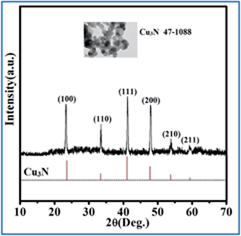 | ||
| Fig. 8 XRD pattern of prepared Cu3N nanoparticles from {[Cu5(CN)6(NH3)6(N3)2]}n (1) heated at 450 °C for 10 h under argon atmosphere. | ||
Conclusions
In conclusion, we have synthesized and characterized the 3-D layered coordination motif in which Cu(II) and Cu(I) centers are linked via μ2,η2 cyano and μ-1,1,3 azido anions. In addition, we also describe the synthesis, and spectroscopic characterization of Cu-azide systems (without cyanide) {[Cu(NH3)2(N3)2]4}n (2), and cyano-bridged Cu(II) analogue (without azide) {[Cu3(NH3)3(CN)4]}n (3), respectively. The TGA analyses and PXRD data show a clean vaporization process without premature side decompositions, and of a clear PXRD pattern dominated by the loss of the cyanide and ammonia ligands and releasing N2 in complex 1. Complexes 2 and 3 are explosive under argon atmosphere; however, pyrolysis of complex 3 in air gave copper oxide. Taken together, these results make the {[Cu5(CN)6(NH3)6(N3)2]}n, an attractive candidate for pure copper nitride nanoparticles.Acknowledgements
We thank the Department of Science and Technology, New Delhi (SR/FT/CS-104/2011) for financial support. Special thanks to Professor Peter J. Sadler, University of Warwick, UK and Professor Jean-Pascal Sutter, Laboratoire de Chimie de Coordination du CNRS, Toulouse, France for their kind encouragement and support.Notes and references
- (a) M. L. Bonnet, C. Aronica, G. Chastanet, G. Pilet, D. Luneau, C. Mathoniere, R. Clerac and V. Robert, Inorg. Chem., 2008, 47, 1127 CrossRef CAS PubMed; (b) A. Escuer, F. A. Mautner, M. A. S. Goher, M. A. M. Abu-oussef and R. Vicente, Chem. Commun., 2005, 605 RSC; (c) E. Q. Gao, Y. F. Yue, S. Q. Bai, Z. He and C. H. Yan, J. Am. Chem. Soc., 2004, 126, 1419 CrossRef CAS PubMed; (d) C.-M. Liu, S. Gao, D.-Q. Zhang, Y.-H. Huang, R.-G. Xiong, Z.-L. Liu, F.-C. Jiang and D.-B. Zhu, Angew. Chem., Int. Ed., 2004, 43, 990 CrossRef CAS PubMed; (e) M. Murugesu, M. Habrych, W. Wernsdorfer, K. A. Abboud and G. Christou, J. Am. Chem. Soc., 2004, 126, 4766 CrossRef CAS PubMed; (f) T. C. Stamatatos, K. A. Abboud, W. Wernsdorfer and G. Christou, Angew. Chem., Int. Ed., 2007, 46, 884 CrossRef CAS PubMed; (g) C. I. Yang, W. Wernsdorfer, G. H. Lee and H. L. Tsai, J. Am. Chem. Soc., 2007, 129, 456 CrossRef CAS PubMed.
- C. Adhikary and S. Koner, Coord. Chem. Rev., 2010, 254, 2933 CrossRef CAS PubMed.
- (a) S. Naiya, C. Biswas, M. G. B. Drew, C. J. Gómez-García, J. M. Clemente-Juan and A. Ghosh, Inorg. Chem., 2010, 49, 6616 CrossRef CAS PubMed; (b) P. Chaudhuri, T. Weyhermtiller, E. Bill and K. Wieghardt, Inorg. Chim. Acta, 1996, 252, 195 CrossRef CAS; (c) J. Ribas, A. Escuer, M. Monfort, R. Vicente, R. Corté, L. Lezama and T. Rojo, Coord. Chem. Rev., 1999, 193, 1027 CrossRef; (d) S. Dalai, P. S. Mukherjee, T. Mallah, M. G. B. Drew and N. R. Chaudhuri, Inorg. Chem. Commun., 2002, 5, 472 CrossRef CAS; (e) S. Mukherjee, Y. P. Patil and P. S. Mukherjee, Dalton Trans., 2012, 41, 54 RSC.
- M. A. S. Goher and T. C. W. Mak, Inorg. Chim. Acta, 1985, 99, 223 CrossRef CAS.
- (a) A. Escuer and G. Aromí, Eur. J. Inorg. Chem., 2006, 4721 CrossRef CAS PubMed; (b) G. S. Papaefstathiou, S. P. Perlepes, A. Escuer, R. Vicente, M. Font-Bardia and X. Solans, Angew. Chem., Int. Ed., 2001, 40, 884 CrossRef CAS; (c) G. S. Papaefstathiou, A. Escuer, R. Vicente, M. Font-Bardia, X. Solans and S. P. Perlepes, Chem. Commun., 2001, 2414 RSC.
- (a) S. Saha, S. Koner, J.-P. Tuchagues, A. K. Boudalis, K.-I. Okamoto and D. Mal, Inorg. Chem., 2005, 44, 6379 CrossRef CAS PubMed; (b) T. Liu, Y.-F. Wang, Z.-M. Wang and S. Gao, Chem.–Asian J., 2008, 3, 950 CrossRef CAS PubMed; (c) J. Ribas, M. Monfort, R. Vicente, R. Cortés, L. Lezama, T. Rojo and M. A. S. Goher, Magnetism: Molecules to Materials II: Molecule-Based Materials, Wiley-VCH Verlag GmbH & Co. KGaA, Weinheim, Germany, 2002 Search PubMed.
- (a) M. A. M. Abu-Youssef, A. Escuer, M. A. S. Goher, F. A. Mautner, G. J. Rei and R. Vicente, Angew. Chem., Int. Ed., 2000, 39, 1624 CrossRef CAS; (b) E. Q. Gao, S. Q. Bai, Z. M. Wang and C. H. Yan, J. Am. Chem. Soc., 2003, 125, 4984 CrossRef CAS PubMed; (c) P. K. Nanda, G. Aromi and D. Ray, Chem. Commun., 2006, 3181 RSC.
- (a) M. Monfort, I. Resino, J. Ribas and H. Stoeckli-Evans, Angew. Chem., Int. Ed., 2000, 39, 191 CrossRef CAS; (b) A. Escuer, R. Vicente, M. A. S. Goher and F. A. Mautner, Inorg. Chem., 1995, 34, 5707 CrossRef CAS; (c) A. Escuer, R. Vicente, M. A. S. Goher and F. A. Mautner, Inorg. Chem., 1997, 36, 3440 CrossRef CAS PubMed; (d) A. Escuer, R. Vicente, M. A. S. Goher and F. A. Mautner, Inorg. Chem., 1996, 35, 6386 CrossRef CAS PubMed.
- (a) F.-C. Liu, Y.-F. Zeng, J. Jiao, X.-H. Bu, J. Ribas and S. R. Batten, Inorg. Chem., 2006, 45, 2776 CrossRef CAS PubMed; (b) A. Escuer, R. Vicente, F. A. Mautner, M. A. S. Goher and M. A. M. Abu-Youssef, Chem. Commun., 2002, 64 RSC; (c) A. Fu, X. Huang, J. Li, T. Yuen and C. L. Lin, Chem.–Eur. J., 2002, 8, 2239 CrossRef CAS; (d) J.-R. Li, Q. Yu, E. C. Saňudo, Y. Tao and X.-H. Bu, Chem. Commun., 2007, 2602 RSC; (e) T. F. Liu, D. Fu, S. Gao, Y. Z. Zhang, H. L. Sun, G. Su and Y. J. Liu, J. Am. Chem. Soc., 2003, 125, 13976 CrossRef CAS PubMed; (f) Y.-Z. Zhang, W. Wernsdorfer, F. Pan, Z.-M. Wang and S. Gao, Chem. Commun., 2006, 3302 RSC; (g) S. Mukherjee and P. S. Mukherjee, Acc. Chem. Res., 2013, 46, 2556 CrossRef CAS PubMed; (h) Z.-G. Gu, J.-L. Zuo and X.-Z. You, Dalton Trans., 2007, 4067 RSC; (i) M. A. M. Abu-Youssef, A. Escuer, F. A. Mautner and L. Ahrstrom, Dalton Trans., 2008, 3553 RSC; (j) Q.-X. Jia, M.-L. Bonnet, E.-Q. Gao and V. Robert, Eur. J. Inorg. Chem., 2009, 3008 CrossRef CAS PubMed; (k) C.-B. Tian, Z.-H. Li, J.-D. Lin, S.-T. Wu, S.-W. Du and P. Lin, Eur. J. Inorg. Chem., 2010, 427 CrossRef CAS PubMed; (l) S. Saha, D. Biswas, P. P. Chakrabarty, A. D. Jana, A. K. Boudalis, S. K. Seth and T. Kar, Polyhedron, 2010, 29, 3342 CrossRef CAS PubMed; (m) Z.-G. Gu, J.-J. Na, B.-X. Wang, H.-P. Xiao and Z. Li, CrystEngComm, 2011, 13, 6415 RSC; (n) Z.-G. Gu, Y.-F. Xu, X.-J. Yin, X.-H. Zhou, J.-L. Zuo and X.-Z. You, Dalton Trans., 2008, 5593 RSC; (o) O. Sengupta, B. Gole, S. Mukherjee and P. S. Mukherjee, Dalton Trans., 2010, 39, 7451 RSC; (p) S. Mukherjee and P. S. Mukherjee, Dalton Trans., 2013, 42, 4019 RSC; (q) S. Mukherjee and P. S. Mukherjee, Inorg. Chem., 2010, 49, 10658 CrossRef CAS PubMed; (r) S. Mukherjee, B. Gole, Y. Song and P. S. Mukherjee, Inorg. Chem., 2011, 50, 3621 CrossRef CAS PubMed; (s) S. Mukherjee, Y. P. Patil and P. S. Mukherjee, Dalton Trans., 2012, 41, 54 RSC.
- (a) S. Konar, E. Zangrando, M. G. B. Drew, T. Mallah, J. Ribas and N. R. Chaudhuri, Inorg. Chem., 2003, 42, 5966 CrossRef CAS PubMed; (b) X. Y. Wang, L. Wang, Z. M. Wang and S. Gao, J. Am. Chem. Soc., 2006, 128, 674 CrossRef CAS PubMed.
- (a) M. A. S. Goher, J. Cano, Y. Journaux, M. A. M. Abu-Youssef, F. A. Mautner, A. Escuer and R. Vicente, Chem.–Eur. J., 2000, 6, 778 CrossRef CAS; (b) D. F. A. Mautner, D. R. Cortés, D. L. Lezama and P. T. Rojo, Angew. Chem., Int. Ed., 1996, 35, 78 CrossRef PubMed; (c) F. A. Mautner, S. Hanna, R. Cortés, L. Lezama, M. G. Barandika and T. Rojo, Inorg. Chem., 1999, 38, 4647 CrossRef CAS PubMed.
- (a) Z.-G. Gu, J.-L. Zuo and X.-Z. You, Dalton Trans., 2007, 4067 RSC; (b) K. C. Mondal and P. S. Mukherjee, Inorg. Chem., 2008, 47, 4215 CrossRef CAS PubMed.
- (a) M. A. S. Goher, A. A. Youssef and F. A. Mautner, Polyhedron, 2006, 25, 1531 CrossRef CAS PubMed; (b) Y.-F. Han, T.-W. Wang, Y. Song, Z. Shen and X.-Z. You, Inorg. Chem. Commun., 2008, 11, 207 CrossRef CAS PubMed; (c) V. Tangoulis, D. Panagoulis, C. P. Raptopoulou and C. Dendrinou-Samara, Dalton Trans., 2008, 1752 RSC.
- L. K. Thompson, S. S. Tandon, F. Lloret, J. Cano and M. Julve, Inorg. Chem., 1997, 36, 3301 CrossRef CAS PubMed.
- T. Nakamura, H. Hayashi, T. Hanaoka and T. Ebina, Inorg. Chem., 2014, 53, 710 CrossRef CAS PubMed.
- (a) H. Wu and W. Chen, J. Am. Chem. Soc., 2011, 133, 15236 CrossRef CAS PubMed; (b) J. L. Choi and E. G. Gillan, Inorg. Chem., 2005, 44, 7385 CrossRef CAS PubMed; (c) D. Wang and Y. Li, Chem. Commun., 2011, 47, 3604 RSC.
- B. S. Furniss, A. J. Hannaford, V. Rogers, P. W. G. Smith and A. R. Tatchell, Vogel's Textbook of Practical Organic Chemistry, 4th edn, Longman, London, 1978 Search PubMed.
- G. M. Sheldrick, Acta Crystallogr., Sect. A: Found. Crystallogr., 2007, 64, 112 CrossRef PubMed.
- (a) G. M. Sheldrick, SHELX-97, Programme for Refinement of Crystal Structures, University of Gottingen, Gottingen, Germany, 1997 Search PubMed; (b) A. L. Spek, PLATON, Acta Crystallogr., Sect. C: Cryst. Struct. Commun., 1990, 46A, C34 Search PubMed.
- (a) G. Lazari, T. C. Stamatatos, C. P. Raptopoulou, V. Psycharis, M. Pissas, S. P. Perlepesa and A. K. Boudalis, Dalton Trans., 2009, 3215 RSC; (b) A. Chakraborty, L. S. Rao, A. K. Manna, S. K. Pati, J. Ribas and T. K. Maji, Dalton Trans., 2013, 42, 10707 RSC; (c) S. Mukherjee, B. Gole, Y. Song and P. S. Mukherjee, Inorg. Chem., 2011, 50, 3621 CrossRef CAS PubMed; (d) Z.-L. Chen, C.-F. Jiang, W.-H. Yan, F.-P. Liang and S. R. Batten, Inorg. Chem., 2009, 48, 4674 CrossRef CAS PubMed; (e) J.-B. Tommasino, G. Chastanet, B. L. Guennic, V. Robert and G. Pilet, New J. Chem., 2012, 36, 2228 RSC.
- H. Wanga, M.-X. Lia, M. Shaob and X. Hea, Polyhedron, 2007, 26, 5171 CrossRef PubMed.
- (a) T. A. Tronic, K. E. deKrafft, M. J. Lim, A. N. Ley and R. D. Pike, Inorg. Chem., 2007, 46, 8897 CrossRef CAS PubMed; (b) K.-M. Park, S. Lee, Y. Kang, S.-H. Moon and S. S. Lee, Dalton Trans., 2008, 6521 RSC; (c) Z. Su, Z. Zhao, B. Zhou, Q. Cai and Y. Zhang, CrystEngComm, 2011, 13, 1474 RSC.
- J.-B. Tommasino, G. Chastanet, B. L. Guennic, V. Robertce and G. Pileta, New J. Chem., 2012, 36, 2228 RSC.
- (a) R. J. Williams, D. T. Cromer and A. C. Larson, Acta Crystallogr., Sect. A: Cryst. Phys., Diffr., Theor. Gen. Crystallogr., 1971, B27, 1701 Search PubMed; (b) V. Vrábel, J. Garaj, J. Sivý and D. Oktavec, Acta Crystallogr., Sect. C: Cryst. Struct. Commun., 1999, C55, 1381 Search PubMed; (c) Y. Song, Y. Xu, T.-W. Wang, Z.-X. Wang and X.-Z. You, J. Mol. Struct., 2006, 788, 206 CrossRef CAS PubMed.
- I. D. Brown, Chem. Rev., 2009, 109, 6858 CrossRef CAS PubMed.
- (a) X. Y. Fan, Z. G. Wu, H. J. Li, B. S. Geng, C. Li and P. X. Yan, J. Phys. D: Appl. Phys., 2007, 40, 3430 CrossRef CAS; (b) L. Gao, A. L. Ji, W. B. Zhang and Z. X. Cao, J. Cryst. Growth, 2011, 321, 157 CrossRef CAS PubMed.
Footnote |
| † Electronic supplementary information (ESI) available. CCDC 971692, 989191 and 952627. For ESI and crystallographic data in CIF or other electronic format see DOI: 10.1039/c4ra05980h |
| This journal is © The Royal Society of Chemistry 2014 |

